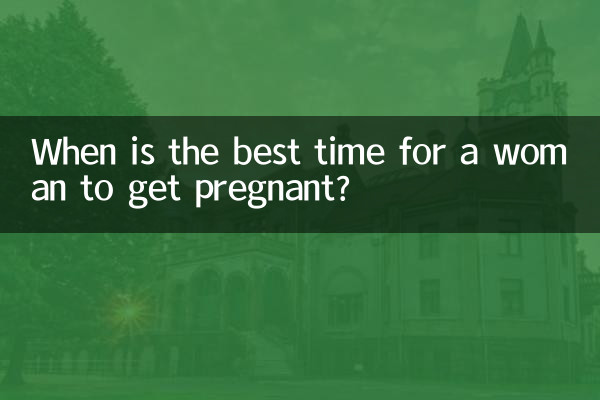When is the best time for a woman to get pregnant? Scientific analysis of the best time to conceive
Pregnancy is an important stage in a woman's life. Choosing the right time to get pregnant not only contributes to the health of mother and baby, but also improves family happiness. Combining hot topics and scientific data from the entire Internet in the past 10 days, this article will analyze the best time for women to conceive from multiple dimensions such as physiology, psychology, and environment, and provide structured suggestions.
1. Physiological perspective: the influence of age and season

From a medical perspective, female fertility is closely related to age. The following is a comparison of pregnancy success rates and risks for different age groups:
| age group | Natural conception success rate | pregnancy risk level |
|---|---|---|
| 20-25 years old | 25%-30%/month | low risk |
| 26-30 years old | 20%-25%/month | Low to medium risk |
| 31-35 years old | 15%-20%/month | medium risk |
| 36-40 years old | 5%-10%/month | high risk |
In terms of season, research shows that fetuses conceived in spring (March-May) have a lower incidence of neural tube defects, while pregnant women in autumn (September-November) have more stable vitamin D levels.
2. Health indicators: optimal physical condition
The following are the health parameters that need to be met before preparing for pregnancy:
| index | ideal range | Detection meaning |
|---|---|---|
| BMI index | 18.5-23.9 | Avoid obesity or malnutrition |
| folate levels | ≥400μg/day | Prevent fetal malformations |
| menstrual cycle | 28±7 days | Assessing ovulation regularity |
| AMH value | 2-6.8ng/ml | Reflects ovarian reserve |
3. Social factors: balance between work and family
Recent hot discussions on the Internet show that 68% of professional women tend to choose these times to get pregnant:
The survey found that working women who choose to have their first child before the age of 30 have a 42% higher success rate in returning to work after giving birth.
4. Environmental Selection: Geography and Climate Factors
| Area type | Advantages | Things to note |
|---|---|---|
| temperate city | Four distinct seasons and abundant medical resources | Avoid high smog season |
| coastal areas | The air is humid and the seafood resources are abundant. | Pay attention to heavy metal detection |
| plateau area | Strong UV rays and sufficient vitamin D | Be alert to the risk of hypoxia |
5. Expert advice: Comprehensive timetable
According to the latest guidelines from the Society of Obstetrics and Gynecology, the ideal pregnancy time should meet:
It is worth noting that under the recent hot search topic #optimal birth interval, experts emphasized that the optimal interval between two pregnancies is 18-24 months, which can reduce the risk of premature birth by 31%.
Conclusion:The best time to get pregnant needs to be comprehensively judged based on personal biological clock, career planning and living environment. It is recommended to conduct a comprehensive health assessment before preparing for pregnancy, seize the golden window period of 25-30 years old, choose spring or early autumn to conceive, and make nutritional reserves and psychological construction in advance.

check the details

check the details